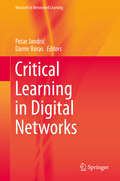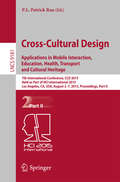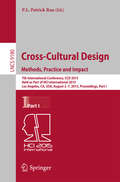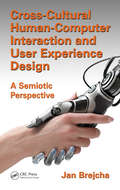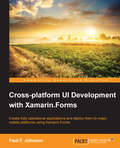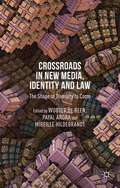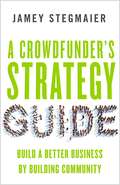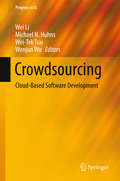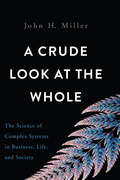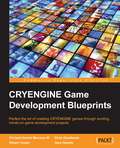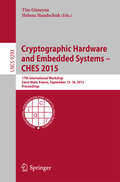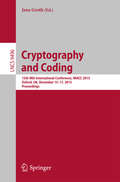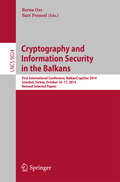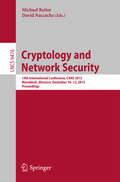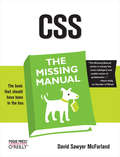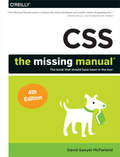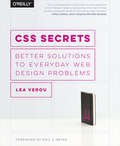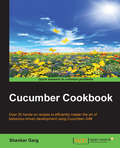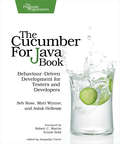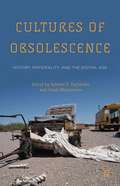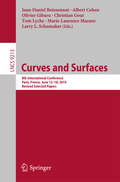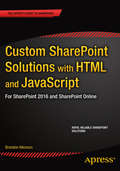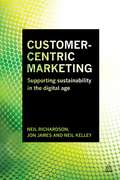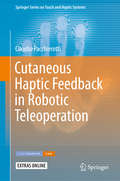- Table View
- List View
Critical Learning in Digital Networks (Research in Networked Learning)
by Petar Jandrić Damir BorasThis ambitious multidisciplinary volume assembles diverse critical-theory approaches to the current and future states of networked learning. Expert contributors expand upon the existing literature by analyzing the ethical aspects of networked learning and the ongoing need for more open, inclusive, and socially engaged educational practice. Chapters explore in depth evolving concepts of real and virtual, the processes of learning in, against, and beyond the internet, and the role of critical pedagogy in improving social conditions. In all, coverage is both realistic and positive about the potential of digital technologies in higher education as well as social and academic challenges on the horizon. Included among the topics: Counting on use of technology to enhance learning. Decentralized networked learning through online pre-publication. The reality of the online teacher. Moving from urban to virtual spaces and back. The project of a virtual emancipatory pedagogy. Using information technologies in the service of humanity. It is no longer a question of "Can technology enhance learning" it's a given that it does. Critical Learning in Digital Networks offers education researchers, teacher educators, instructional technologists, and instructional designers tools and methods for strengthening this increasingly vital interconnection.
Critical Perspectives on Technology and Education
by Scott Bulfin Nicola F. Johnson Chris BigumThis book offers critical readings of issues in education and technology and demonstrates how researchers can use critical perspectives from sociology, digital media, cultural studies, and other fields to broaden the "ed-tech" research imagination, open up new topics, ask new questions, develop theory, and articulate an agenda for informed action.
Cross-Cultural Design Applications in Mobile Interaction, Education, Health, Transport and Cultural Heritage: 7th International Conference, CCD 2015, Held as Part of HCI International 2015, Los Angeles, CA, USA, August 2-7, 2015, Proceedings, Part II (Lecture Notes in Computer Science #9181)
by P.L. Patrick RauThe two LNCS volume set 9180-9181 constitutes the refereed proceedings of the 7th International Conference on Cross-Cultural Design, CCD 2015, held as part of the 17th International Conference on Human-Computer Interaction, HCII 2015, in Los Angeles, CA, USA in August 2015, jointly with 15 other thematically similar conferences. The total of 1462 papers and 246 posters presented at the HCII 2015 conferences were carefully reviewed and selected from 4843 submissions. These papers of the two volume set address as follows: LNCS 9180, Cross-Cultural Design: Methods, Practice and Impact (Part I), addressing the following major topics: cross-cultural product design, cross-cultural design methods and case studies, design, innovation, social development and sustainability and LNCS 9181, Cross-Cultural Design: Applications in Mobile Interaction, Education, Health, Transport and Cultural Heritage (Part II), addressing the following major topics: cultural aspects of social media and mobile services, culture for transport and travel, culture for design and design for culture and culture for health, learning and games.
Cross-Cultural Design Methods, Practice and Impact: 7th International Conference, CCD 2015, Held as Part of HCI International 2015, Los Angeles, CA, USA, August 2-7, 2015, Proceedings, Part I (Lecture Notes in Computer Science #9180)
by P.L.Patrick RauThe two LNCS volume set 9180-9181 constitutes the refereed proceedings of the 7th International Conference on Cross-Cultural Design, CCD 2015, held as part of the 17th International Conference on Human-Computer Interaction, HCII 2015, in Los Angeles, CA, USA in August 2015, jointly with 15 other thematically similar conferences. The total of 1462 papers and 246 posters presented at the HCII 2015 conferences were carefully reviewed and selected from 4843 submissions. These papers of the two volume set address as follows: LNCS 9180, Cross-Cultural Design: Methods, Practice and Impact (Part I), addressing the following major topics: cross-cultural product design, cross-cultural design methods and case studies, design, innovation, social development and sustainability and LNCS 9181, Cross-Cultural Design: Applications in Mobile Interaction, Education, Health, Transport and Cultural Heritage (Part II), addressing the following major topics: cultural aspects of social media and mobile services, culture for transport and travel, culture for design and design for culture and culture for health, learning and games.
Cross-Cultural Human-Computer Interaction and User Experience Design: A Semiotic Perspective
by Jan BrejchaThis book describes patterns of language and culture in human-computer interaction (HCI). Through numerous examples, it shows why these patterns matter and how to exploit them to design a better user experience (UX) with computer systems. It provides scientific information on the theoretical and practical areas of the interaction and communication design for research experts and industry practitioners and covers the latest research in semiotics and cultural studies, bringing a set of tools and methods to benefit the process of designing with the cultural background in mind.
Cross-platform UI Development with Xamarin.Forms
by Paul F. JohnsonCreate a fully operating application and deploy it to major mobile platforms using Xamarin.Forms About This Book * Create standard user interfaces on Windows Mobile, Android, and iOS and then make those interfaces look good with ease * Design a full-blown application in very little time with just about the entire code being shared * Learn how to access platform-specific features and still have the same core code with this handy guide Who This Book Is For This book is intended for mobile software developers who are fed up with having three different code sets for the same application. If you want to put your code on all mobile platforms with minimum fuss, and just want to develop but haven't got the time to be digging too far into a particular platform, this is the book for you. Basic knowledge of C# is assumed. What You Will Learn * Create a responsive UI, modified to suit the target platform * Understand the basics of designing an application, and the considerations needed for target platforms * Construct a complete app using a single codebase * Develop attractive user interfaces * Bind information to the code behind to generate a reactive application * Design an effective portable class library (PCL) * Include a Windows Mobile application within your standard Xamarin.Forms application * Extend your applications using the Xamarin.Forms Labs library In Detail Xamarin is an IDE used for the development of native iOS, Android, and Windows, and cross-platform mobile applications in C#. For the mobile developer, that means learning three different languages to create the same application. Even if you use the Xamarin toolchain, you still need to work with three different user interface construction sets. Xamarin is essentially a container in which developers can write any application in C# and use the Xamarin compiler to package and deploy on Android, iOS, or Windows platforms. To top this, Xamarin.Forms plays the role of a single codebase for mobile applications. This book will show you, with fully-coded examples, how to use both the Xamarin toolchain and the Xamarin.Forms library to code once for the three platforms. It goes from the concept and design of a mobile messenger application to its execution. You will be introduced to Messenger--the messaging app--which includes key features such as push notifications, UI, maps, databases, and web services. Next, you will learn to plan the UI using Xamarin.Forms for cross-mobile platform development, and move on to creating custom buttons, extending the UI, and connecting to social sites such as Facebook and Twitter. You will also learn about the limitations of PCL libraries and how they make coding easier. This will be followed by the creation of a SQLite database and a database manager, and the SQLite database's reflection within the database manager. You will then be taken through the use of hardware features with ample coverage of iOS, Android, and Windows Mobile. Finally, the book will conclude by introducing common strategies that allow you to create applications that "just work" without having to reinvent the wheel each time. Style and approach A fun and informal approach to creating a mobile application using the most up-to-date cross-platform approach. Each coding chapter includes fully working code examples available for download from the Packt Publishing website.
Crossroads in New Media, Identity and Law
by Wouter De Been Payal Arora Mireille HildebrandtThis volume brings together a number of timely contributions at the nexus of new media, politics and law. The central intuition that ties these essays together is that information and communication technology, cultural identity, and legal and political institutions are spheres that co-evolve and interpenetrate in myriad ways. Discussing these shifting relationships, the contributions all probe the question of what shape diversity will take as a result of the changes in the way we communicate and spread information: that is, are we heading to the disintegration and fragmentation of national and cultural identity, or is society moving towards more consolidation, standardization and centralization at a transnational level? In an age of digitization and globalization, this book addresses the question of whether this calls for a new civility fit for the 21st century.
A Crowdfunder’s Strategy Guide
by Jamey StegmaierMore Than MoneyJamey Stegmaier knows crowdfunding. He's a veteran of seven successful Kickstarter campaigns (and counting) that have raised over $1.4 million, and he's the proprietor of the widely read Kickstarter Lessons blog. In this book he offers a comprehensive guide to crowdfunding, demonstrating that it can be a powerful way for entrepreneurs to grow their businesses by building community and putting their customers first.This book includes over forty stories of inspiring successes and sobering disasters. Stegmaier uses these examples to demonstrate how to (and how not to) prepare for a campaign, grow a fan base, structure a pitch, find new backers, and execute many other crucially important "nuts and bolts" elements of a successful crowdfunding project.But Stegmaier emphasizes that the benefits of crowdfunding are much more about the "crowd" than the "funding." He shows that if you treat your backers as people, not pocketbooks--communicate regularly and transparently with them, ask their opinions, attend to their needs--they'll become advocates as well as funders, exponentially increasing your project's chances of succeeding.
Crowdsourcing: Cloud-Based Software Development (Progress in IS)
by Wei Li Michael N. Huhns Wei-Tek Tsai Wenjun WuThis book presents the latest research on the software crowdsourcing approach to develop large and complex software in a cloud-based platform. It develops the fundamental principles, management organization and processes, and a cloud-based infrastructure to support this new software development approach. The book examines a variety of issues in software crowdsourcing processes, including software quality, costs, diversity of solutions, and the competitive nature of crowdsourcing processes. Furthermore, the book outlines a research roadmap of this emerging field, including all the key technology and management issues for the foreseeable future. Crowdsourcing, as demonstrated by Wikipedia and Facebook for online web applications, has shown promising results for a variety of applications, including healthcare, business, gold mining exploration, education, and software development. Software crowdsourcing is emerging as a promising solution to designing, developing and maintaining software. Preliminary software crowdsourcing practices and platforms, including Apple's App Store and TopCoder, demonstrate the advantages of crowdsourcing in terms of software ecosystem expansion and product quality improvement.
A Crude Look at the Whole: The Science of Complex Systems in Business, Life, and Society
by John H. MillerImagine trying to understand a stained glass window by breaking it into pieces and examining it one shard at a time. While you could probably learn a lot about each piece, you would have no idea about what the entire picture looks like. This is reductionism--the idea that to understand the world we only need to study its pieces--and it is how most social scientists approach their work. In A Crude Look at the Whole, social scientist and economist John H. Miller shows why we need to start looking at whole pictures. For one thing, whether we are talking about stock markets, computer networks, or biological organisms, individual parts only make sense when we remember that they are part of larger wholes. And perhaps more importantly, those wholes can take on behaviors that are strikingly different from that of their pieces. Miller, a leading expert in the computational study of complex adaptive systems, reveals astounding global patterns linking the organization of otherwise radically different structures: It might seem crude, but a beehive’s temperature control system can help predict market fluctuations and a mammal’s heartbeat can help us understand the "heartbeat” of a city and adapt urban planning accordingly. From enduring racial segregation to sudden stock market disasters, once we start drawing links between complex systems, we can start solving what otherwise might be totally intractable problems. Thanks to this revolutionary perspective, we can finally transcend the limits of reductionism and discover crucial new ideas. Scientifically founded and beautifully written, A Crude Look at the Whole is a powerful exploration of the challenges that we face as a society. As it reveals, taking the crude look might be the only way to truly see.
CRYENGINE Game Development Blueprints
by Chris Goodswen Richard Gerard Marcoux IIIPerfect the art of creating CRYENGINE games through exciting, hands-on game development projects About This Book * Create CRYENGINE games from scratch with CRYENGINE Blank Game Starter-kit * Discover good working practices and tips to quickly jump into making a new level in the game * Build practical game projects and discover advanced concepts of CRYENGINE game development using the examples in the book Who This Book Is For This book is intended for CRYENGINE game developers, wanting to develop their skills with the help of industry experts. A good knowledge level and understanding of CRYENGINE is assumed, to allow efficient programming of core elements and applications. What You Will Learn * Create a CRYENGINE game from scratch with the Game Starter-kit * Add custom methods to allow the player/AI to use a weapon * Create complete "start" and "end" game menus using Scaleform and C++ * Discover how to use highpoly modeling workflow and techniques within the pipeline for the SDK to use * Use the Crytiff exporter from Photoshop * Export the CHR--the format the engine needs to read the skeleton * Integrate the character in the engine using the character tool * Better understand the rules to create and author skeletons to rig characters designed for CRYENGINE * Debug common setup issues that might appear during production with useful tools In Detail CRYENGINE is a game engine developed by Crytek for PC, Playstation, Xbox, Android, and iOS. It can be used to create AAA games, movies, high-quality simulations, and interactive applications. It is most popularly used for game development. In this book, you will start off by exploring the CRYENGINE "Blank" Game Starter-kit, creating a completely playable character from scratch and controlling its movement. You will learn how to implement a weapon and ammo class, and will create complete "start" and "end" game menus using Scaleform and C++. Additionally, you will learn some key texturing techniques for PBR and how to create and bake maps to the lowpoly model. You will also explore how to get a static model from Maya and shaders setbup in the SDK to check the textures during creation, and create all the necessary engine files to export and see the game character's animations in your engine. In the final third of the book, you will learn how to create objectives, set up saved games, layer on audio polish to help immerse the player in the experience, and debug game issues. Style and approach An easy-to-follow, practical guide covering three exciting projects. As you work through each project you will explore new topics including complex animation, advanced scripting, and complex character motion. All the code used in each project is explained in detail.
Cryptographic Hardware and Embedded Systems -- CHES 2015: 17th International Workshop, Saint-Malo, France, September 13-16, 2015, Proceedings (Lecture Notes in Computer Science #9293)
by Tim Güneysu Helena HandschuhThis book constitutes the refereed proceedings of the 17th International Workshop on Cryptographic Hardware and Embedded Systems, CHES 2015, held in Saint Malo, France, in September 2015. The 34 full papers included in this volume were carefully reviewed and selected from 128 submissions. They are organized in the following topical sections: processing techniques in side-channel analysis; cryptographic hardware implementations; homomorphic encryption in hardware; side-channel attacks on public key cryptography; cipher design and cryptanalysis; true random number generators and entropy estimations; side-channel analysis and fault injection attacks; higher-order side-channel attacks; physically unclonable functions and hardware trojans; side-channel attacks in practice; and lattice-based implementations.
Cryptography and Coding: 15th IMA International Conference, IMACC 2015, Oxford, UK, December 15-17, 2015. Proceedings (Lecture Notes in Computer Science #9496)
by Jens GrothThis book constitutes the proceedings of the 15th IMA International Conference on Cryptography and Coding, IMACC 2015, held at Oxford, UK, in December 2015. The 18 papers presented together with 1 invited talk were carefully reviewed and selected from 36 submissions. The scope of the conference was on following topics: authentication, symmetric cryptography, 2-party computation, codes, Boolean functions, information theory, and leakage resilience.
Cryptography and Information Security in the Balkans: First International Conference, BalkanCryptSec 2014, Istanbul, Turkey, October 16-17, 2014, Revised Selected Papers (Lecture Notes in Computer Science #9024)
by Berna Ors Bart PreneelThis book constitutes revised selected papers from the First International Conference on Cryptography and Information Security in the Balkans, Balkan Crypt Sec 2014, held in Istanbul, Turkey, in October 2014. The 15 papers presented in this volume were carefully reviewed and selected from 36 submissions. They were organized in topical sections named: symmetric cryptography, cryptographic hardware, cryptographic protocols and public key cryptography. The book also contains one invited talk in full paper length.
Cryptology and Network Security: 14th International Conference, CANS 2015, Marrakesh, Morocco, December 10-12, 2015, Proceedings (Lecture Notes in Computer Science #9476)
by Michael Reiter David NaccacheThis book constitutes the refereed proceedingsof the 14th International Conference on Cryptology and Network Security, CANS2015, held in Marrakesh, Morocco, in December 2015. The 12 full papers presented together with 6short papers were carefully reviewed and selected from numerous submissions. Thepapers cover topics of interest such as internet of things and privacy;password-based authentication; attacks and malicious code; security modelingand verification; secure multi-party computation; and cryptography and VPNs.
CSS: The Missing Manual
by David Sawyer McfarlandWeb site design has grown up. Unlike the old days, when designers cobbled togetherchunky HTML, bandwidth-hogging graphics, and a prayer to make their sites look good,Cascading Style Sheets (CSS) now lets your inner designer come out and play. But CSSisn't just a tool to pretty up your site; it's a reliable method for handling allkinds of presentation--from fonts and colors to page layout. CSS: The MissingManual clearly explains this powerful design language and how you can use it tobuild sparklingly new Web sites or refurbish old sites that are ready for an upgrade.Like their counterparts in print page-layout programs, style sheets allowdesigners to apply typographic styles, graphic enhancements, and precise layoutinstructions to elements on a Web page. Unfortunately, due to CSS's complexity andthe many challenges of building pages that work in all Web browsers, most Web authorstreat CSS as a kind of window-dressing to spruce up the appearance of their sites.Integrating CSS with a site's underlying HTML is hard work, and often frustratinglycomplicated. As a result many of the most powerful features of CSS are left untapped.With this book, beginners and Web-building veterans alike can learn how to navigatethe ins-and-outs of CSS and take complete control over their Web pages'appearance.Author David McFarland (the bestselling author of O'Reilly's Dreamweaver: TheMissing Manual) combines crystal-clear explanations, real-world examples, a dashof humor, and dozens of step-by-step tutorials to show you ways to design sites withCSS that work consistently across browsers. You'll learn how to:Create HTML that's simpler, uses less code, is search-engine friendly, andworks well with CSSStyle text by changing fonts, colors, font sizes, and adding bordersTurn simple HTML links into complex and attractive navigation bars-completewith CSS-only rollover effects that add interactivity to your Web pagesStyle images to create effective photo galleries and special effects likeCSS-based drop shadowsMake HTML forms look great without a lot of messy HTMLOvercome the most hair-pulling browser bugs so your Web pages work consistentlyfrom browser to browserCreate complex layouts using CSS, including multi-column designs that don'trequire using old techniques like HTML tablesStyle Web pages for printingUnlike competing books, this Missing Manual doesn't assume that everyone in theworld only surfs the Web with Microsoft's Internet Explorer; our book providessupport for all major Web browsers and is one of the first books to thoroughlydocument the newly expanded CSS support in IE7, currently in beta release.Want to learn how to turn humdrum Web sites into destinations that will captureviewers and keep them longer? Pick up CSS: The Missing Manual and learn thereal magic of this tool.
CSS: The Missing Manual (Missing Manual Ser.)
by David Sawyer McfarlandCSS lets you create professional-looking websites, but learning its finer points can be tricky—even for seasoned web developers. This fully updated edition provides the most modern and effective tips, tricks, and tutorial-based instruction on CSS available today. Learn how to use new tools such as Flexbox and Sass to build web pages that look great and run fast on any desktop or mobile device. Ideal for casual and experienced designers alike.The important stuff you need to know:Start with the basics. Write CSS-friendly HTML, including the HTML5 tags recognized by today’s browsers.Design for mobile devices. Create web pages that look great when visitors use them on the go.Make your pages work for you. Add animations that capture the imagination, and forms that get the job done.Take control of page layouts. Use professional design techniques such as floats and positioning.Make your layouts more flexible. Design websites with Flexbox that adjust to different devices and screen sizes.Work more efficiently. Write less CSS code and work with smaller files, using Syntactically Awesome Stylesheets (Sass).
CSS Secrets
by Lea VerouIn this practical guide, CSS expert Lea Verou provides 47 undocumented techniques and tips to help intermediate-to advanced CSS developers devise elegant solutions to a wide range of everyday web design problems.Rather than focus on design, CSS Secrets shows you how to solve problems with code. You'll learn how to apply Lea's analytical approach to practically every CSS problem you face to attain DRY, maintainable, flexible, lightweight, and standards-compliant results.Inspired by her popular talks at over 60 international web development conferences, Lea Verou provides a wealth of information for topics including:Backgrounds and BordersShapesVisual EffectsTypographyUser ExperienceStructure and LayoutTransitions and Animations
Cucumber Cookbook
by Shankar GargThis book is intended for business and development personnel who want to use Cucumber for behavior-driven development and test automation. Readers with some familiarity with Cucumber will find this book of most benefit. Since the main objective of this book is to create test automation frameworks, previous experience in automation will be helpful.
The Cucumber for Java Book: Behaviour-Driven Development for Testers and Developers
by Seb Rose Matt Wynne Aslak HellesoyTeams working on the JVM can now say goodbye forever to misunderstood requirements, tedious manual acceptance tests, and out-of-date documentation. Cucumber - the popular, open-source tool that helps teams communicate more effectively with their customers - now has a Java version, and our bestselling Cucumber Book has been updated to match. The Cucumber for Java Book has the same great advice about how to deliver rock-solid applications collaboratively, but with all code completely rewritten in Java. New chapters cover features unique to the Java version of Cucumber, and reflect insights from the Cucumber team since the original book was published.Until now it's been difficult for teams developing Java applications to learn how to benefit from Behaviour-Driven Development (BDD). This book changes all that by describing in detail how to use Cucumber to harness the power of plain language specifications in your development process.In part 1, you'll discover how to use Cucumber's Gherkin DSL to describe the behavior your customers want from the system. You'll also learn how to write Java code that interprets those plain language specifications and checks them against your application. Part 2 guides you through a worked example, using Spring, MySQL, and Jetty. Enhanced chapters teach you how to use Selenium to drive your application and handle asynchronous Ajax calls, and new chapters cover Dependency Injection (DI) and advanced techniques to help keep your test suites fast. Part 3 shows you how to integrate Cucumber with your Continuous Integration (CI) system, work with a REST web service, and even use BDD with legacy applications.Written by the creator of Cucumber and two of its most experienced users and contributors, The Cucumber for Java Book is an authoritative guide that will give you and your team all the knowledge you need to start using Cucumber with confidence.
Cultures of Obsolescence
by Babette B. Tischleder Sarah WassermanObsolescence is fundamental to the experience of modernity, not simply one dimension of an economic system. The contributors to this book investigate obsolescence as a historical phenomenon, an aesthetic practice, and an affective mode. Because obsolescence depends upon the supersession and disappearance of what is old and outmoded, this volume sheds light on what usually remains unseen or overlooked. Calling attention to the fact that obsolescence can structure everything from the self tothe skyscraper, Cultures of Obsolescence asks readers to rethink existing relationships between the old and the new. Moreover, the essays in this volume argue for the paradoxical ways in which subjects and their concepts of the human, of newness, and of the future are constituted by a relationship to the obsolete.
Curves and Surfaces: 8th International Conference, Paris, France, June 12-18, 2014, Revised Selected Papers (Lecture Notes in Computer Science #9213)
by Albert Cohen Tom Lyche Larry L. Schumaker Jean-Daniel Boissonnat Olivier Gibaru Christian Gout Marie-Laurence MazureThis volume constitutes the thoroughly refereed post-conference proceedings of the 8th International Conference on Curves and Surfaces, held in Paris, France, in June 2014. The conference had the overall theme: "Representation and Approximation of Curves and Surfaces and Applications". The 32 revised full papers presented were carefully reviewed and selected from 39 submissions. The scope of the conference was on following topics: approximation theory, computer-aided geometric design, computer graphics and visualization, computational geometry and topology, geometry processing, image and signal processing, interpolation and smoothing, mesh generation, finite elements and splines, scattered data processing and learning theory, sparse and high-dimensional approximation, subdivision, wavelets and multi-resolution method.
Custom SharePoint Solutions with HTML and JavaScript: For SharePoint On-Premises and SharePoint Online
by Brandon AtkinsonCustom SharePoint Solutions with HTML and JavaScript shows you how to build and customize SharePoint solutions to suit a wide range of business needs. You don't need a background in Microsoft technologies; you'll learn how to rapidly build and customize sites entirely on the front end, starting with out-of-the-box features and extending them with HTML and JavaScript code. The book starts with an introduction to working with SharePoint on the front end, and how this can help you avoid common pitfalls associated with deploying custom code on the server. You'll start by using SharePoint's browser-based tools to place and manipulate out-of-the-box web parts on a page. Then learn to inject some simple HTML and JavaScript to manipulate these web parts, and use JSLink to rapidly style and manipulate data in the List web part. You'll also see examples of how to build your own custom web parts using HTML, JavaScript and CSS. For those who want to dive deeper into JavaScript on SharePoint, chapters cover working directly with built-in JavaScript methods and properties and the JavaScript object model (JSOM), and how to work with the powerful new REST API, which gives you the ultimate flexibility over what you do with your data. Whatever your background, whether it's web development, working with SharePoint on the server side, or if you're a SharePoint user looking to learn new skills, Custom SharePoint Solutions with HTML and JavaScript will show you how to get what you want from SharePoint, quickly and reliably. What you'll learn Understand the advantages of working with SharePoint on the front end, using HTML and JavaScript. Use the Content Editor and Script Editor web parts to customize your front end directly in the browser. Work with SharePoint's built-in JavaScript methods and properties and the JavaScript object model. Access and manipulate data using the powerful REST API. Build your own custom web parts. Use JSLink to style and manipulate list data. Who this book is for Web or front end developers, . NET developers, and SharePoint users. No prior JavaScript experience is needed for many of the OOTB solutions, but a little is desirable if you want to make the most of what the customizations offer. Experienced JavaScript developers will additionally benefit from the deep dives into JavaScript features in Chapters 4-6. Table of Contents Chapter 1: Setting Up Your Environment Chapter 2: Introduction to SharePoint Front End Solutions Chapter 3: Content Editor and Script Editor Web Parts Chapter 4: Working With SharePoint's Built-in JavaScript Methods and Properties Chapter 5: The JavaScript Object Model Chapter 6: Working With Data Using the REST API Chapter 7: Building Custom Web Parts Using HTML and JavaScript Chapter 8: Using JSLink to Style List Web Parts Chapter 9: Content Search Web Part and Display Templates
Customer-Centric Marketing
by Jon James Neil Richardson Neil KelleyTwo of the major parallel challenges facing businesses today are how to adapt to the changes of fast-paced, fragmenting markets and how to grow a business whilst engaging in recognisably sustainable practices. It is not enough to just be sustainable, it is about communicating it and getting the customer involved in the message. Customer-Centric Marketing shows readers how sustainable development practices and digital marketing techniques work naturally together to add value, leading to improved customer satisfaction, better professional relationships and increased effectiveness.Ideal for senior marketing professionals and students on digital marketing or marketing strategy modules who wish to utilise the benefits of sustainable development and forms of digital marketing, this accessible and straight to-the-point book uses case studies to show how the marketing theories and tools work in actual business scenarios. Customer-Centric Marketing covers contemporary issues such as the increasing use of mobile, QR codes and social network sites for consumers interested in ethical, environmental and sustainable marketing.
Cutaneous Haptic Feedback in Robotic Teleoperation (Springer Series on Touch and Haptic Systems #0)
by Claudio PacchierottiThis work addresses the challenge of providing effective cutaneous haptic feedback in robotic teleoperation, with the objective of achieving the highest degree of transparency whilst guaranteeing the stability of the considered systems. On the one hand, it evaluates teleoperation systems that provide only cutaneous cues to the operator, thus guaranteeing the highest degree of safety. This cutaneous-only approach shows intermediate performance between no force feedback and full haptic feedback provided by a grounded haptic interface, and it is best suitable for those scenarios where the safety of the system is paramount, e. g. , robotic surgery. On the other hand, in order to achieve a higher level of performance, this work also investigates novel robotic teleoperation systems with force reflection able to provide mixed cutaneous and kinesthetic cues to the operator. Cutaneous cues can compensate for the temporary reduction of kinesthetic feedback necessary to satisfy certain stability conditions. This state-of-the-art volume is oriented toward researchers, educators, and students who are interested in force feedback techniques for robotic teleoperation, cutaneous device design, cutaneous rendering methods and perception studies, as well as readers from different disciplines who are interested in applying cutaneous haptic technologies and methods to their field of interest.
